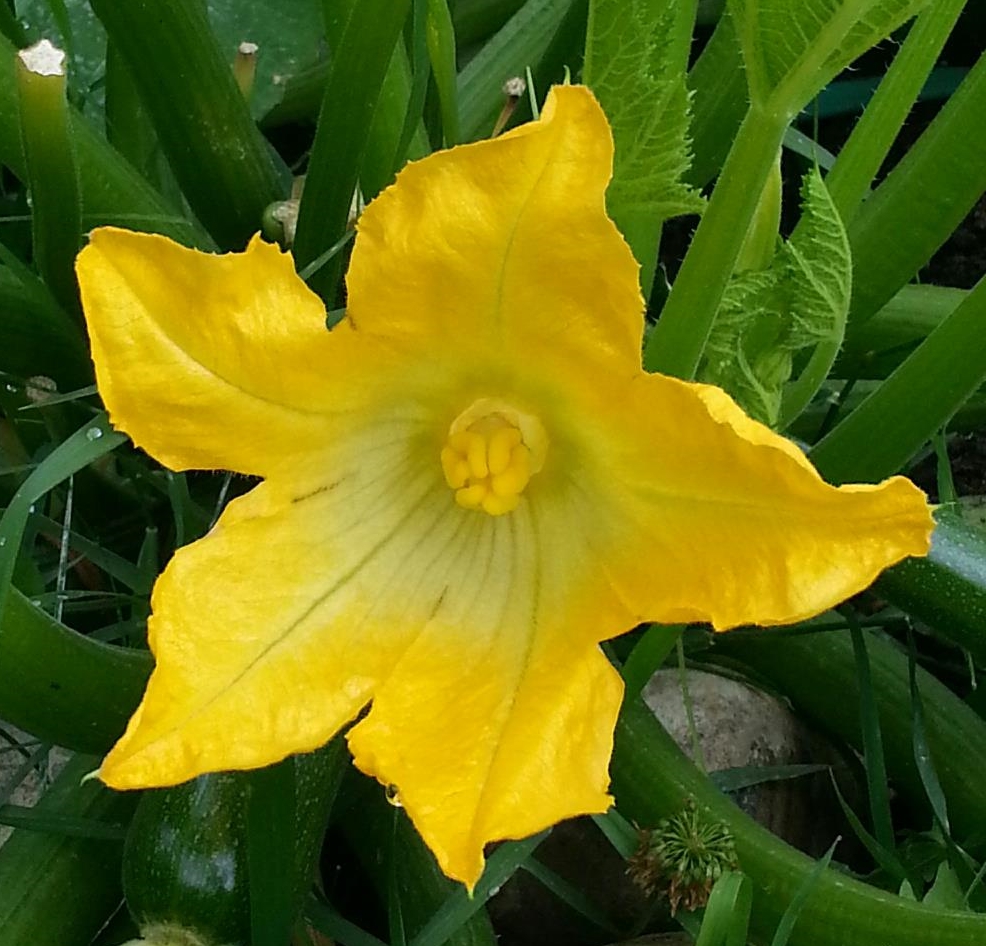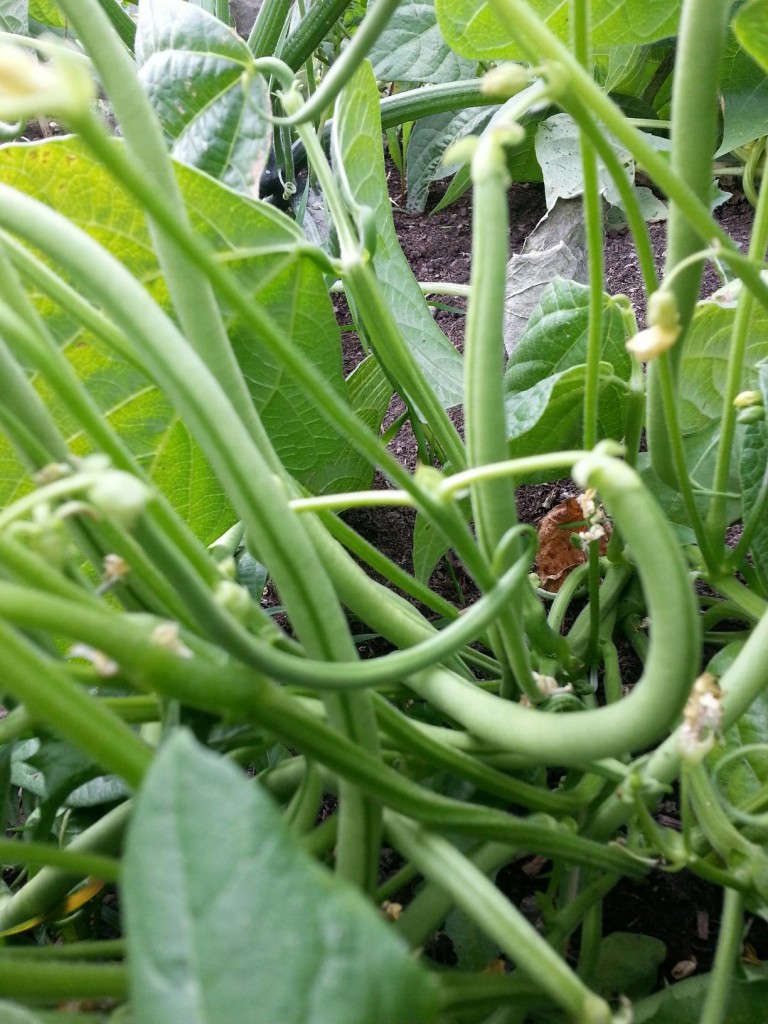Canmore Community Gardening Society
Growing Food! Building Community! Gardening Together!
2014 Beans and Squash
Beans and Squash Report 2014
What we grew: Summer squash: Amatista Grey (mildew resistant), Gold Rush, White Courgette. We decided last year to no longer plant winter squash as the season is too short here.
Beans: Bush: Tema, Royal Burgundy, other odds and ends. Pole: Purple Peacock. We also grew a few Red Celery plants with the bush beans as they are recommended as a companion.
Timing and planting: Squash seeds were started at home in 3-4” pots by team members the last week of April, moved to the site under the covers mid-may and planted out May 23, under the covers. Recommend this schedule (depending on weather)space plants minimum 20 inches apart. You need to start 30-40 plugs, one seed per plug is fine and it’s OK if some don’t germinate. Goal is 20-25 plants. When planting, pick off any flowers (they can be eaten) to encourage the plants to grow bigger before starting to set fruit. Milestones: Started to see fruit forming July 13.
Bush beans were direct-sown May 31, under covers. Pole beans were direct sown June 11, after the last frost, in an uncovered bed. Recommendation: if the weather is nice, plant the bean seed by the 3rd week of May, spacing the seed 3-4 across the bed (6-8 inches apart). They germinate well and blank spaces can be filled in later. Milestones: bush bean plants emerged June 11 (10 days) First blossoms July 13.
Celery: plants were started in March and planted out June 16 (could have been done earlier). Recommend plants to be started much earlier, maybe by the 1st week of February. Other than never catching up in size, the plants grew very well and healthy.
Growing/harvest timing: the 1st summer squash are usually ready to start harvesting the 1st week of August, when they are at least 5-6 inches long and the blossom has fallen off. They will continue to produce into October if the weather permits. The 1st bush beans will also be ready to start picking early August, when they get to about 4”long. They will produce into September but are usually done by the end of September. Squash and beans can both get much larger and still be delicious, and Members should be instructed to harvest the very largest they can find to a minimum size of 5” for zukes and 4” for beans. UNTIL a hard killing frost is forecast (or snowstorm) at which time everyone needs to get down to the garden and pick EVERYTHING before the plants get killed and food ruined.
Soil additives: No soil or amendments were added this year, except eggshell powder was added to the holes when transplanting the squash, and in June a Gaia fertilizer application (4-4-4) was applied to all the Communal beds. Recommend adding dolomite lime to the beds to increase calcium supply and avoid blossom end rot in the squash. Recommend adding more soil/compost for volume to the covered beds.
Covers: Beds had covers put on at the Opening work party May 11, to allow the soil to start heating up as beans and squash both need warm soil temperatures. If the weather is nice this can be done as early as the start of May. Note a thick heavy snowfall will collapse the covers so watch the forecast, no point doing anything if there is snow predicted. Covers need to be secured taught to prevent sagging to work effectively, if there is a frost, any part of the plant that is touching the plastic will die back. We left the covers on until the last week of June, taking them off during the day when necessary if the day was warm but then replacing to keep the temperature warmer over night. At the end of June we left them off but stayed on standby in case there was a frost warning in which case we would have had to go down and put the covers on for the night. The zucchini plants did not grow as large or produce as much fruit this year as they have in the past when covered more diligently all summer. Wondering if the cold nights in July and August contributed to this, but also suspect it was the varieties we chose to plant this year, selecting mildew-resistance over productivity. Soaker hoses were laid in the hoop beds to make it easier to water with the covers on.
Pests and Diseases: May-June, we had some cutworms. The squash plants were large enough by the time they were planted that they were not affected. The celery was not affected. We lost a few bush beans but not a big deal. We sprinkled cornmeal around the plants and this worked really well.
In past years we have had a problem with powdery mildew on the squash leaves. This was one of the reasons for leaving the beds uncovered all summer, to allow more air circulation. Measures to reduce mildew include staying on top of the weeding and leaving the covers off as much as possible to promote air circulation, laying 2 soaker hoses along the length of the bed with the holes down to reduce the amount of water landing on the leaves, and rotating the beds. 2015 the beans should be grown in the South bed (closest to the front gate) and the squash should be grown in the North bed. Mildew was not a problem for us this year. If it does appear it can be cured easily by spraying with a 50/50 solution of cow’s milk and water on a sunny day. The protein reacts with the sunlight to kill the mildew. It works really well. Note- in past years when we did have mildew, it did not affect the health of the plants or fruit production – it was just kind of gross. Mildew usually appears early to mid July.
The slugs were awful this year! They were prolific throughout the garden, but they love beans in particular (squash was not affected) and at least part of the reason we had them so bad this year was because the plants were too close and we as a team were very horrible at weeding so the bush bean bed, in spite of not being covered in july and August, was damp and humid with minimal air circulation and the slugs just loved it. Despite the slugs eating their fair share, the bush bean crop was abundant and delicious. Advice: plants no more than 4 across (8inches apart), stay on top of the weeds, set out and maintain beer traps early in the season (it would be nice to find a way to NOT kill the black ground beetles though; they EAT slugs!) research ways to attract preditors of slugs into the bean bed. There is also pick’n’squish, bait with a board or rhubarb leaf… Pouring salt on them is not recommended as the salt will contaminate the soil. August was Slug Season.
We had bad blossom end rot this year in spite of the eggshell in the hole. Blossom end rot is caused by a calcium deficiency which might be due to lack of supply but may also be due to inability to absorb. This year when we saw the rot again we made a solution of calcium in an easy-to-absorb form (not eggshell) (Tums solution) and sprayed it on the leaves, in the hopes the plant would absorb some calcium quickly and the new fruits would not have the rot. Plants can absorb nutrients through their leaves the same way we can absorb mineral spirits and nicotine through our skin. This needs to be done after peak sun hours, late afternoon or evening. Recommend dolomite lime to be added to the soil to ensure a ready supply of calcium to the plants, and consistent but not over – watering to ensure healthy roots that can absorb the nutrients needed. Once the plants start to set fruit, end of July into August, you will see if there is blossom end rot by looking at the forming fruits. It cannot be reversed in fruits where it already exists but it can be avoided in new fruits on the same plant if you can get calcium into the plant. Tomatoes had the same problem.
There was also some kind of leaf-cutter insect that took sections of squash leaves, very symmetrically. Not sure what it was or how to prevent it. (update: I think it might have been leaf cutter bees. The plants were still healthy.)
There is an ant nest toward the middle of the South Bed, and another at one end of the pole bean bed. Ants don’t really do anything bad though (unless they are leaf-cutter ants?!) Tiny little black ants. They may be farming aphids somewhere but I didn’t really notice it, mostly just a be-aware thing as it’s kind of gross to look down and your hand is swarmed with little ants.
Seed: Bush Beans – we have plenty of Tema and Royal Burgundy for 2015. Pole beans were a failed experiment, they grew and were beautiful plants but died before they could set fruit.
Summer squash: order Amatista Grey (for the mildew resistance), Jackpot (green), Goldie (yellow), Black Beauty (dk.green).
Celery: lots of seed left.
Team organization: We made a schedule on Google Docs assigning each Team Member a fixed day of the week to be responsible to check on the garden, water if needed, remove or put on covers if needed, and report anything of interest to the Team. We were to get another team member to cover our day if we were going to be away. This worked well and everything stayed alive and healthy. Everyone was supposed to weed whenever they could and I think I was the only one doing trouble shooting and pest control but that wasn’t on purpose. Everyone was welcome to call work parties if they wanted to and we got together a few times early in the season to plant but as summer progressed our schedules did not match up well.

